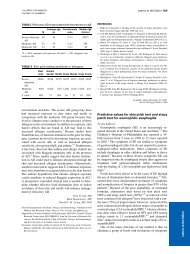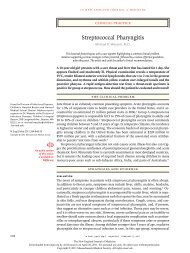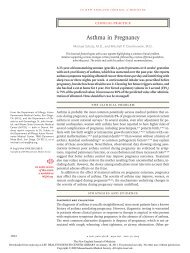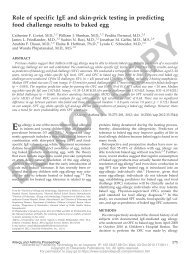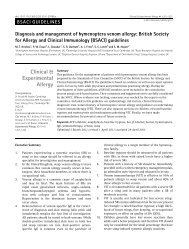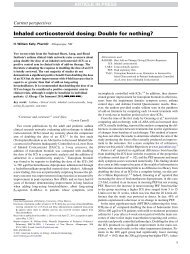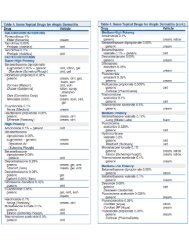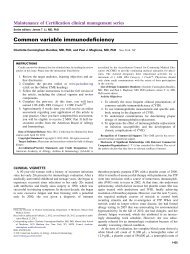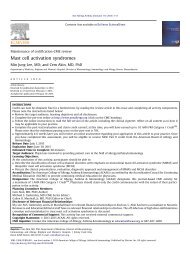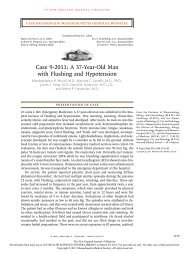IMPORTANT - AInotes
IMPORTANT - AInotes
IMPORTANT - AInotes
Create successful ePaper yourself
Turn your PDF publications into a flip-book with our unique Google optimized e-Paper software.
mouthpiece or to twist it unnecessarily; it is fixed to the inhaler<br />
and must not be taken off.<br />
As the amount of powder dispensed is very small, you may not be<br />
able to taste or feel it after inhalation. However, you can still be<br />
confident that the dose has been inhaled if you have followed the<br />
instructions.<br />
Stopping SYMBICORT TURBUHALER<br />
Talk to your doctor about how to gradually stop your medication if<br />
necessary. It is important that you do not suddenly stop taking<br />
SYMBICORT TURBUHALER as it may cause unwanted side<br />
effects.<br />
Cleaning: Clean the outside of the mouthpiece once a week with a<br />
dry tissue. Never use water or any other fluid when cleaning the<br />
mouthpiece. If fluid enters the inhaler it may not work properly.<br />
When to start a new inhaler: SYMBICORT TURBUHALER has<br />
a dose indicator. The dose indicator tells you how many doses are<br />
left in the inhaler. The dose indicator moves slowly each time you<br />
load a dose. Every 20th dose is marked with a number and every<br />
10th dose is marked with a dash. When the "0" on the red<br />
background has reached the middle of the window you should<br />
discard your inhaler. The sound you hear when you shake the<br />
inhaler is produced by a drying agent, not the medication.<br />
SYMBICORT TURBUHALER cannot be re-filled with drug and<br />
should be discarded.<br />
SIDE EFFECTS AND WHAT TO DO ABOUT THEM<br />
Like all medicines, SYMBICORT may cause unwanted reactions,<br />
so-called side effects. Most patients do not experience side effects<br />
from SYMBICORT.<br />
The most commonly reported side effects of SYMBICORT are:<br />
headache, sensation of heart beat, cough, irritation of mouth and/or<br />
throat and hoarseness.<br />
Less commonly reported side effects of SYMBICORT include:<br />
nausea, sleep difficulties, restlessness or nervousness, dizziness and<br />
muscle cramps.<br />
If any of these side effects concern you, do not stop treatment, but<br />
tell your doctor about them.<br />
Additional side effects including skin rash and bruising, itching,<br />
facial swelling, increase in chest tightness, chest pain, depression or<br />
behavioural disturbances and high blood sugar levels were also<br />
reported rarely.<br />
Tell your doctor if you are exposed to chicken pox or measles while<br />
using this medication, as you may be more prone to infection.<br />
If you had been taking oral corticosteroids to treat your asthma and<br />
you suddenly have a severe asthma attack when starting<br />
SYMBICORT TURBUHALER, contact your doctor immediately.<br />
In patients with asthma, you should TELL YOUR DOCTOR if:<br />
OVERDOSE:<br />
Dose indicator shows that it is<br />
time to start a new inhaler<br />
In case of drug overdose, contact a health care practitioner,<br />
hospital emergency department or regional Poison Control<br />
Centre immediately, even if there are no symptoms.<br />
The most common signs and symptoms that may occur after<br />
overdosage are trembling, headache and rapid heartbeat.<br />
MISSED DOSE:<br />
If you miss a dose of SYMBICORT TURBUHALER, take it as<br />
soon as you remember and then go back to your regular schedule.<br />
Never take a double dose of SYMBICORT TURBUHALER to<br />
make up for missed doses. If you are still unsure, check with your<br />
doctor or pharmacist to see what you should do.<br />
• The relief of your asthma is not as good as usual or does not<br />
last as long as usual. A change from “usual” includes more<br />
wheezing, coughing, tightness or shortness of breath.<br />
• You exceed the maximum total number of daily inhalations (8<br />
inhalations/day).<br />
• There is a persistent increase in your use of fast-acting reliever<br />
medication.<br />
• Your symptoms are waking you up at night.<br />
• Measurement from your peak flow meter indicates a value<br />
between 60% and 80% of predicted or personal best.<br />
These may be signs that your asthma is getting worse. Your doctor<br />
may adjust your treatment.<br />
You should TELL YOU DOCTOR RIGHT AWAY or go to the<br />
nearest hospital if you notice the following warning signs:<br />
• A sudden worsening of your shortness of breath and<br />
wheezing shortly after using your fast-acting medication.<br />
• You do not feel relief from additional doses of your fastacting<br />
reliever medication.<br />
• Measurement from your peak flow meter indicates a value<br />
less than 60 percent of predicted or personal best.<br />
• You are breathless at rest.<br />
• Your pulse is more than 120 beats per minute.<br />
COPYRIGHT 2002, 2009, 2011 ASTRAZENECA CANADA INC. Page 4 of 6



